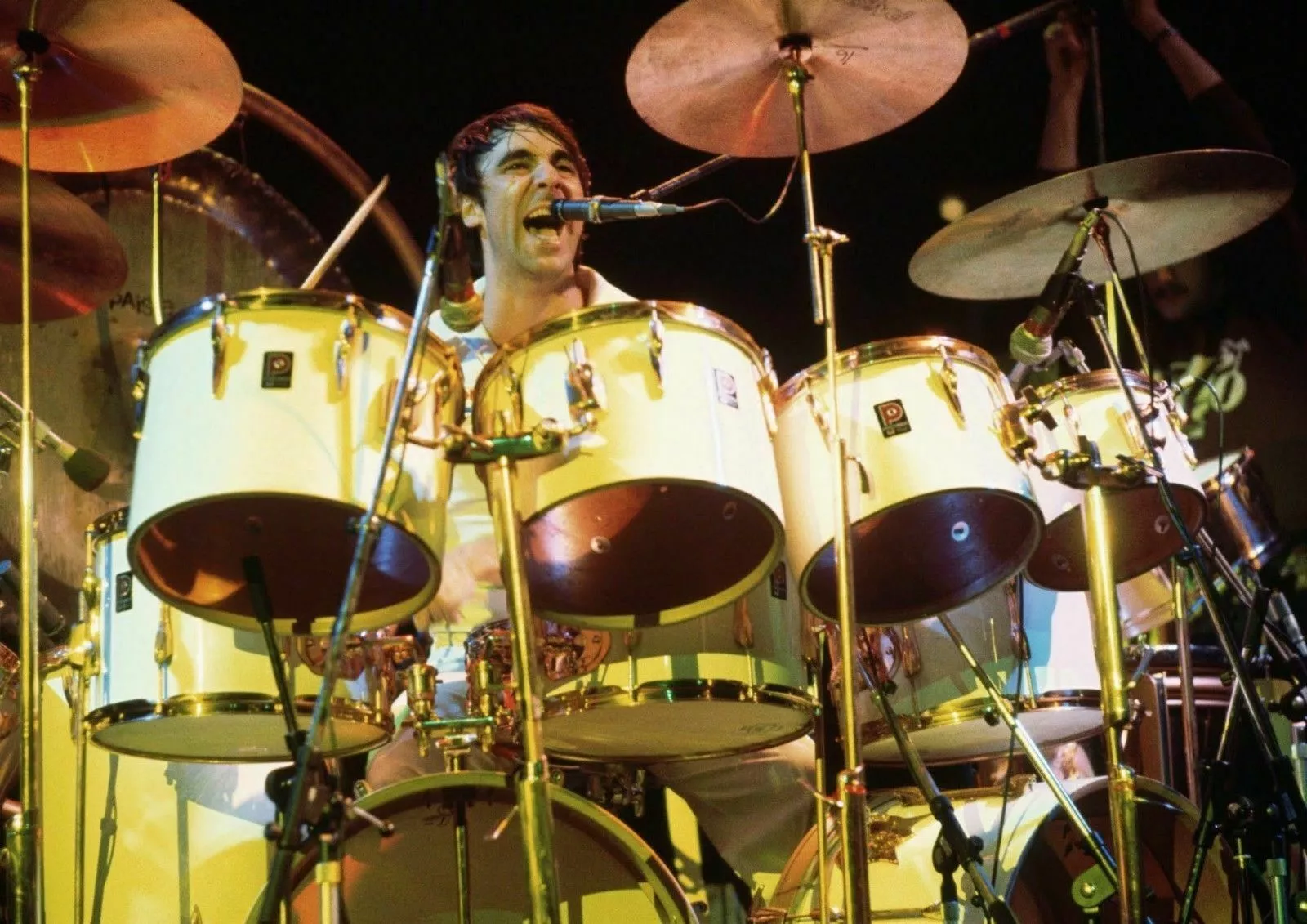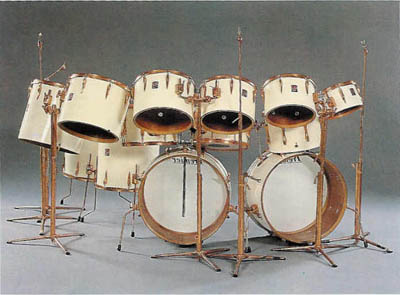INSTRUMENTS
Amplifier (unknown make/model)
In the brochure photo of the live room, we can see what looks like a amplifier head and cabinet against the wall. The poor resolution makes it pretty much impossible to definitively identify it though. The amp that springs to mind when I see it, however, is a HH IC100-S. The HH IC100-S was perhaps most famous as an amp sometimes used by Ringo's friend and collaborator Marc Bolan. The cabinet even has the large trim of a VamPower 4x12 cab which Bolan also used. This is, of course, is all pure conjecture.

ARP 2500 Synthesizer
The Startling Studios brochure lists an ARP 2500 synthesizer amongst the instruments available at the studio. I haven't been able to find any photos of the 2500 at Startling, but I think that its possible it was kept in the main house as opposed to the live room.
The 2500 was a large modular-style synthesizer manufactured in the early to mid 1970s. After the success of the Wendy Carlos album Switched on Bach which was recorded using a Moog synthesizer, the ARP company was formed in 1969 by an electronics engineer called Alan R. Pearlman. The 2500 cabinet could fit 15 customizable modules. Unlike most synthesisers, the 2500's moduals were routed by a matrix switching system as opposed to a patch cable system. ARP also made "wing" cabinets for expanding the 2500 that could each hold 8 additional modules. Without any photos its impossible to know the specific configuration at Startling.
Fender Rhodes Mark I Suitcase Eight-Eight Electric Piano
In the below photo of the live room we can see a Fender Rhodes Mark I Suitcase Eight-Eight which is listed in the studio brochure as a "Fender Rhodes 88 stereo electric piano". Eight-eight key Mark I suitcases branded as a "Fender" were manufactured from 1972 through 1975.
The Rhodes keyboard is a electro-mechanical keyboard. Like a traditional piano, Rhodes use keys and hammers but instead of striking a string, the hammer strikes a metallic tine that is then amplified by a magnetic pickup. The "suitcase" version of Rhodes pianos have a built-in amplifier with two speakers. Suitcase pianos have a "vibrato" control which bounces the sound between the two speakers (though this effect is actually tremolo, not vibrato). Rhodes have been used on literally countless hits since the 1960s and are sought-after studio keyboards to this day.

Fender Twin Reverb
In the brochure photo of the live room, we can see a miced up guitar amp (with what looks like a star stenciled on the side) on a chair. According to studio manager Mike O'Donnell, the amp "was a Fender twin reverb and the star stuck on the side was a sticky label Ringo had made to stick on all his amps."
In the 2015 auction of his property, Ringo sold two late '60s Twin Reverb's. The listings for those auctions can be seen here and here.

Hamond C3 Organ w/ Leslie Speaker
The Startling Studios brochure lists a Hammond C3 organ with a Leslie speaker cabinet. The Hammond C3 is internally exactly the same as the more famous B3, except it has solid sides and back instead of sitting on legs. Because I cant find any photos, I'm not sure what model Leslie speaker was with the C3, but the usual suspects would be a 122, 147, or 145.
Ludwig Downbeat Drum Set
According to the liner notes for Ringo's 1983 album Old Wave, Ringo had three drum sets at Startling: "Ringo's original black pearl Beatle Ludwig set; a larger "blonde" wood-finish Ludwig kit, which first saw the light of day in the Let It Be and Abbey Road sessions (and used sparsely since); and a clear plastic Ludwig Vistalite set given to him by the company at the time of his "Ringo" TV special in 1978."
Ringo used four different black oyster pearl drum sets with The Beatles, but if the kit referred to above is indeed the original Ludwigs, that would be his 1963 Ludwig Downbeat kit.
The liner notes explain that in 1983, the Downbeats and Hollywoods both still had their original heads "The older sets still had their original calf-skin heads on them," recalls [recording engineer Jim] Nipar, noting the exception of the snare drums, which had modern plastic heads.
The specs of the #1 Ludwig Downbeat's are as follows:
5.5" x 14" Jazz Festival snare drum, date stamped: APR 18 1963 (pre-serial # and keystone badge)
12” x 8” tom; 6-lug; keystone badge (pre-serial #)
14” x 14” floor tom; 8-lug; keystone badge (pre-serial #)
20” x 14” bass drum; 8-lug; keystone badge (pre-serial #)
All drums are 3-ply Mahogany/Poplar/Mahogany. The toms and snare had white Resa-Cote painted interiors, the interior of the bass drum was unpainted.
The Downbeat's (minus the snare) were sold by Ringo in 2015 through Julian's Auctions. The listing can be viewed here. For lots of great info on Ringo's Beatle kits, check out: www.ringosbeatlekits.com.

Ludwig Hollywood Drum Set
According to the liner notes for Ringo's 1983 album Old Wave, Ringo had three drum sets at Startling: "Ringo's original black pearl Beatle Ludwig set; a larger "blonde" wood-finish Ludwig kit, which first saw the light of day in the Let It Be and Abbey Road sessions (and used sparsely since); and a clear plastic Ludwig Vistalite set given to him by the company at the time of his "Ringo" TV special in 1978."
The liner notes explain that in 1983, the Downbeats and Hollywoods both still had their original heads "The older sets still had their original calf-skin heads on them," recalls [recording engineer Jim] Nipar, noting the exception of the snare drums, which had modern plastic heads. Nipar decided to try a newer plastic head on one of the tom-toms on the Abbey Road [Hollywood] set, and began removing the original. "I was in the process of unscrewing the thing when Ringo walked in and saw what I was doing. He got a look on his face I'll never forget. He said 'You don't do that.'" The historic drum set still had a certain magic to it, even to Ringo."
The specs of the Ludwig Hollywood's are as follows:
8" x 12" tom; 6-lug; keystone badge; serial # 469170; date stamped: MAR 24 1967
9" x 13" tom; 6-lug; keystone badge; serial # 464609; date stamped: MAR 28 1967
16" x 16" floor tom; 8-lug; keystone badge; serial # 466825; date stamp unknown
14" x 22" bass drum; 10-lug; keystone badge; serial # 470730; date stamped MAR 24 1967
All drums are 3-ply Maple/Poplar/Mahogany w/ white Resa-Cote painted interiors.
Ringo still owns the Ludwig Hollywood's. For lots of great info on Ringo's Beatle kits, check out: www.ringosbeatlekits.com.

Ludwig Tivoli Vistalite Drum Set
According to the liner notes for Ringo's 1983 album Old Wave, Ringo had three drum sets at Startling: "Ringo's original black pearl Beatle Ludwig set; a larger "blonde" wood-finish Ludwig kit, which first saw the light of day in the Let It Be and Abbey Road sessions (and used sparsely since); and a clear plastic Ludwig Vistalite set given to him by the company at the time of his "Ringo" TV special in 1978."
The Vistalites were the drums used for recording Old Wave (the only Ringo Starr album to be mostly recorded at Startling) due to Ringo's instance that the heads on the Downbeat and Hollywood kits not be changed. The liner notes continue "Producer, drummer and engineer concluded the Vistalites would do just fine. [Recording engineer Jim] Nipar began tuning them for Ringo. "I said, 'How do you like them tuned?'" Starr's reply was as basic as his drumming Philosophy: "I just hit 'em."
The specs of the Vistalites are as follows:
14” x 5” snare; 10-lug; Blue Olive Badge serial number 1686056.
12” x 8” tom; 6-lug; Blue Olive badge serial number 1685874.
14” x 10” tom; 6-lug; Blue Olive badge serial number 1685855.
16” x 16” floor tom; 8-lug; Blue Olive badge serial number 1685880.
24” x 14” bass drum; 10-lug; Blue Olive badge serial number 1686030.
The Vistalites were sold by Ringo in 2015 through Julian's Auctions. The listing can be viewed here.

Premier Drum Set
Zak Starkey, photographed recording at Startling/Tittenhurst circa 1979/1980 is playing a custom white Premier Drum Set . This drum set was originally made for Zak's Godfather, the one and only Keith Moon. Moon used this kit with The Who from October 1976 to October 1976 before he gave it to Ringo, who subsequently gave it to Zak.
In its original configuration with Moon, the Premier kit consisted of:
2x 22″ kick drums
1x 10″ x 6½″ concert tom
1x 12″ x 8″ concert tom
1x 13″ x 9″ single-headed (concert) tom
1x 14″ x 10″ concert tom
3x 14 x 10 toms
1x 15″ x 12 ″ concert tom
1x 16″ x 16 ″ concert tom
1 16″ x 18″ floor tom
1 18″ floor tom
1 Gretsch snare
1 or 2 Premier 22½ timpani
Polished copper hardware. Moon apparently wanted gold but Premier convinced him that gold would not be a durable choice given his style of play and the demands of the road.
I'm not sure how much of the kit made to Zak, but the configuration we see in the below photo is definitely a stripped down - albeit still absurdly large - version of the kit. Zak ended up giving the kit to The Astoria Theatre in London in 1988 to be a part of their "Keith Moon Bar."

Below left, Moon on this kit (photo by Neal Preston) and below right is the photo from the Sotheby’s London auction catalog when the kit was sold in 1992.
Tip of the hat to the great TheWho.Net where most of the information on this kit came from!
Yamaha C3 Grand Piano
The Startling Studios brochure lists a "Yamaha grand piano". After Startling Studios closed in the late 1980s, studio manager Mike O'Donnell bought all of the gear and installed it at his new studio Bluebird Themes. The Bluebird brochure lists a Yamaha C3 piano, so there's a good chance that it came from Startling with the other gear which would make the Yamaha at Startling a C3.
I believe the piano was probably always kept in the main house due to the small size of the studio's live room. At 6'1", the C3 is smaller than its more famous brother the C7 (7′ 6″), but it still would have still taken up a significant chunk of real-estate in the relatively small live room. Below is a photo of Neil Murray & Jon Lord of Whitesnake at the Yamaha C3 in 1980. I believe they are in what was formerly the dining room.

This site is for educational and research purposes only.
Fair Use Copyright Disclaimer under section 107 of the Copyright Act of 1976, allowance is made for “fair use” for purposes such as criticism, comment, news reporting, teaching, scholarship, education and research.
Fair use is a use permitted by copyright statute that might otherwise be infringing.
Fair Use Definition Fair use is a doctrine in United States copyright law that allows limited use of copyrighted material without requiring permission from the rights holders, such as commentary, criticism, news reporting, research, teaching or scholarship. It provides for the legal, non-licensed citation or incorporation of copyrighted material in another author’s work under a four-factor balancing test.


